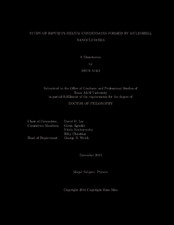| dc.contributor.advisor | Lee, David Morris | |
| dc.creator | Mao, Shun | |
| dc.date.accessioned | 2015-04-28T15:35:39Z | |
| dc.date.available | 2015-04-28T15:35:39Z | |
| dc.date.created | 2014-12 | |
| dc.date.issued | 2014-12-17 | |
| dc.date.submitted | December 2014 | |
| dc.identifier.uri | https://hdl.handle.net/1969.1/154143 | |
| dc.description.abstract | Impurity-helium condensates (IHCs) are porous gel-like materials created by injecting a mixed beam of helium gas and an impurity gas into super fluid 4He. Van der Waals forces lead to the formation of clusters of impurities each surrounded by a thin layer of solid helium. Inside super fluid helium the clusters tend to aggregate into a gel-like structure with wide distribution of pore sizes. Matrix isolation of free radical impurities in IHCs leads to unusually high concentrations of these impurities.
Impurity-helium condensates (IHCs) containing nitrogen and krypton atoms immersed in super fluid 4He have been studied via a CW electron spin resonance (ESR) technique. It was found that the addition of krypton atoms to the nitrogen-helium gas mixture used for preparation of IHCs increases efficiency of stabilization of nitrogen atoms. We have achieved high average (5x10^19 cm^-3) and local (2x10^21 cm^-3) concentrations of nitrogen atoms in krypton-nitrogen-helium condensates. High concentrations of nitrogen atoms achieved in IHCs provide an important step in the search for magnetic ordering effects at low temperatures.
Impurity-helium condensates created by injection of hydrogen (deuterium) atoms and molecules as well as rare gas (RG) atoms (Ne and Kr) into super fluid 4He also have been studied via electron spin resonance (ESR) techniques. Measurements of the ground-state spectroscopic parameters of hydrogen and deuterium atoms show that the nanoclusters have a shell structure. H and D atoms reside in solid molecular layers of H2 and D2, respectively. By monitoring the recombination of H atoms in the collection of hydrogen-neon nanoclusters, we show that nanoclusters form a gel-like porous structure which enables the H atoms to be transported through the structure via percolation. Observation of percolation in the collection of nanoclusters containing stabilized hydrogen atoms opens new possibilities for a search for macroscopic collective quantum phenomena at ultralow temperatures accessible by a dilution refrigerator. | en |
| dc.format.mimetype | application/pdf | |
| dc.language.iso | en | |
| dc.subject | Nanoclusters | en |
| dc.subject | Electron Spin Resonance | en |
| dc.subject | Low temperature physics | en |
| dc.subject | Optical spectroscopy | en |
| dc.subject | Chemiluminescence | en |
| dc.subject | Radiofrequency discharge | en |
| dc.title | Study of Impurity-Helium Condensates Formed by Multishell Nanoclusters | en |
| dc.type | Thesis | en |
| thesis.degree.department | Physics and Astronomy | en |
| thesis.degree.discipline | Physics | en |
| thesis.degree.grantor | Texas A & M University | en |
| thesis.degree.name | Doctor of Philosophy | en |
| thesis.degree.level | Doctoral | en |
| dc.contributor.committeeMember | Agnolet, Glenn | |
| dc.contributor.committeeMember | Kocharovsky, Vitaly | |
| dc.contributor.committeeMember | Hilty, Christian | |
| dc.type.material | text | en |
| dc.date.updated | 2015-04-28T15:35:39Z | |
| local.etdauthor.orcid | 0000-0002-2882-1869 | |


